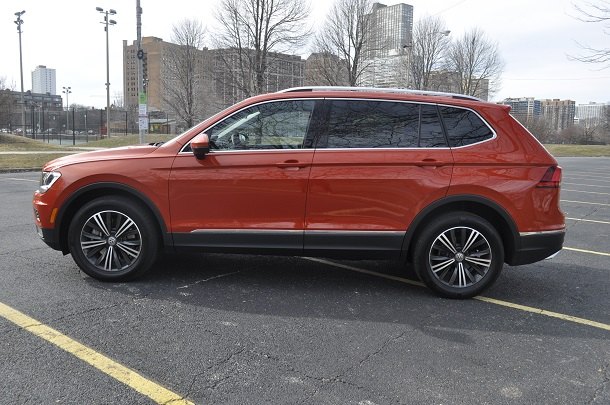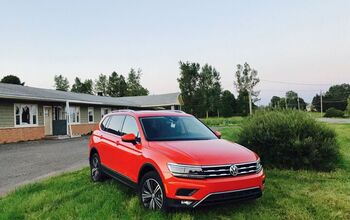2018 Volkswagen Tiguan SEL W/4Motion Review - Crossover Done Well

2018 Volkswagen Tiguan SEL w/ 4Motion
Many crossovers are really just tall wagons, and the 2018 Volkswagen Tiguan looks the part. It has a boxy overall shape with angles and curves mixed in. Drop its ride height, and it’s a wagon.
Fine. That’s sort of the point – crossovers promise the utility of wagons with a taller seating position. We’ve been over this before.
Getting a crossover to stand out requires a little extra effort, beyond just being a tall wagon. In the case of the Tiguan, Volkswagen remembered that it’s the same company that makes the Golf/Golf GTI, and has the MQB platform available for use in underpinning its compact crossover. Unlike the larger, bulkier Atlas, which also shares the platform but is tuned for comfort – the Tiguan makes better use of the sportier aspects of its platform.
I credit light and lively steering for some of this. Yes, light steering is usually lambasted as being a detriment, mostly due to lack of feel, but it works here, and it’s just heavy enough to remind you of its connection to the road.
The Tiguan weighs nearly two tons with all-wheel drive, yet manages to feel light on its feet, at least relative to other crossovers of its size. Credit the front strut-type and rear multi-link suspension. There is some body roll, however — something you might expect from what’s essentially a tall wagon.
Volkswagen doesn’t sacrifice too much ride comfort for spryness, but it’s not completely smooth sailing, either. Too much is a key phrase, here – there is some sacrifice. Just not a lot.
Asking a turbocharged 2.0-liter four-banger to haul nearly two tons of curb weight is a dicey proposition, but even with just 184 horsepower and 221 lb-ft of torque, there’s enough verve on hand for the cut and thrust of the urban jungle. I’d be wary of freeway passing, though. The eight-speed automatic thankfully blends into the background.
Inside is the familiar-by-now Volkswagen cabin ethic – black and simple, with a logical control layout. You get two knobs for audio/infotainment control (thanks, Wolfsburg) along with a large center screen that rests above three large HVAC controls and a row of climate buttons. If you’ve been in any other MQB vehicles in recent times, you’ll feel right at home.
I had no issues with comfort – there’s space aplenty up front and reasonable space for adults in the rear. A larger center console would’ve been nice, though. Rear cargo behind the optional third row is 12 cubic feet, and with the third row down, the measurement is a couple cubic feet lower than what’s offered on the five-seat Honda CR-V or Nissan Rogue.
Speaking of the third row, it seems a bit unnecessary and useless in a crossover of this size. As noted above, it cuts into cargo space. Volkswagen will tell you that it gives the Tiguan a leg up over the five-seat crossovers it competes against, but most buyers who want or need a third row are going a size up in class. Five seats is probably just fine at this price point and size.
If the Tiguan tickles your crossover fancy, you have four trims from which to choose – S, SE, SEL, and SEL Premium. I was sent an SEL with 4Motion all-wheel drive, which has a base price of $33,850. You can scoop up an S for as low as $24,595, and even the SE keeps the base sticker under $30K.
Opting for the SEL with 4Motion snags you all-wheel drive, 18-inch wheels, all-season rubber, LED daytime running lights, front fog lamps, heated side view mirrors, silver roof rails, panoramic sunroof, dual-zone climate control, heated front seats, leatherette seats, rear-view camera, adaptive cruise control, forward-collision warning and autonomous emergency braking with pedestrian monitoring, blind-spot monitoring with rear-traffic alert, keyless entry with push-button start, infotainment with navigation and USB ports, Bluetooth, satellite radio, remote power liftgate, Android Auto, and Apple CarPlay.
Options were limited to the $295 Habanero Orange paint job and $500 for the third-row seats. The destination fee is $900.
This particular tall wagon is smartly styled, relatively engaging to drive, and well-appointed. The $35K sticker is a bit dear when compared to the CR-V (a loaded Touring starts about $3K less), top-trim Rogue ($2K or so), or the Limited RAV 4 (the Platinum-trimmed RAV4, which lines up against the SEL Premium Tiguan, starts at a tick over $36K).
Sometimes you have to pay more for better. The Tiguan is less boring and bland than the Rogue and it’s a bit bigger than the RAV4 (although the RAV4 boast greater cargo volume). It’s not perfect or cheap, but Volkswagen has a well-built CUV on its hands.
[Images © 2018 Tim Healey/TTAC]

Tim Healey grew up around the auto-parts business and has always had a love for cars — his parents joke his first word was “‘Vette”. Despite this, he wanted to pursue a career in sports writing but he ended up falling semi-accidentally into the automotive-journalism industry, first at Consumer Guide Automotive and later at Web2Carz.com. He also worked as an industry analyst at Mintel Group and freelanced for About.com, CarFax, Vehix.com, High Gear Media, Torque News, FutureCar.com, Cars.com, among others, and of course Vertical Scope sites such as AutoGuide.com, Off-Road.com, and HybridCars.com. He’s an urbanite and as such, doesn’t need a daily driver, but if he had one, it would be compact, sporty, and have a manual transmission.
More by Tim Healey
Latest Car Reviews
Read moreLatest Product Reviews
Read moreRecent Comments
- ToolGuy I do like the fuel economy of a 6-cylinder engine. 😉
- Carson D I'd go with the RAV4. It will last forever, and someone will pay you for it if you ever lose your survival instincts.
- THX1136 A less expensive EV would make it more attractive. For the record, I've never purchased a brand new vehicle as I have never been able to afford anything but used. I think the same would apply to an EV. I also tend to keep a vehicle way longer than most folks do - 10+ years. If there was a more affordable one right now then other things come to bear. There are currently no chargers in my immediate area (town of 16K). I don't know if I can afford to install the necessary electrical service to put one in my car port right now either. Other than all that, I would want to buy what I like from a cosmetic standpoint. That would be a Charger EV which, right now, doesn't exist and I couldn't afford anyway. I would not buy an EV just to be buying an EV. Nothing against them either. Most of my constraints are purely financial being 71 with a disabled wife and on a fixed income.
- ToolGuy Two more thoughts, ok three:a) Will this affordable EV have expressive C/D pillars, detailing on the rocker panels and many many things happening around the headlamps? Asking for a friend.b) Will this affordable EV have interior soft touch plastics and materials lifted directly from a European luxury sedan? Because if it does not, the automotive journalists are going to mention it and that will definitely spoil my purchase decision.c) Whatever the nominal range is, I need it to be 2 miles more, otherwise no deal. (+2 rule is iterative)
- Zerofoo No.My wife has worked from home for a decade and I have worked from home post-covid. My commute is a drive back and forth to the airport a few times a year. My every-day predictable commute has gone away and so has my need for a charge at home commuter car.During my most recent trip I rented a PHEV. Avis didn't bother to charge it, and my newly renovated hotel does not have chargers on the property. I'm not sure why rental fleet buyers buy plug-in vehicles.Charging infrastructure is a chicken and egg problem that will not be solved any time soon.






































Comments
Join the conversation
I find the styling of the new Tiguan refreshing with simple creases, nice proportions and trim that accents not overpowers. Contrast it with the snoot and the mawl of the RAV4 or the overwrought tail lights of the CRV...or the cheapness of the Rouge. And no gimmicky "floating roof". VW's design language is very much in keeping with its Teutonic heritage....refreshing and will age well.
Just bought one of these (2018 Comfortline 4Motion with Panoroof) for the wife last week (East Coast of Canada). That is after car shopping for the better part of two months and comparing: * Tucson (liked it but the 2018 could no longer be had in blue), * Sportage (too cramped for me at 6"2'), * CRV (could not get over the butt fugly interior - who designed this?!), * Rogue (spacious but super boring), * CX5 (most fun to drive but too small and w/o Android Auto - it's 2018 ffs!) * Escape (felt the cheapest out of the whole bunch) The Tiguan is silver white and we quite like its looks. It is not for back road carving or even spirited driving, but it's spacious, feels very well made (actually downright premium compared to the Escape), and the wife wants to drive something that is high off the ground. Personally, I am more of a wagon / hatch / shooting brake kinda guy as evidenced by the fact that I am driving an Outback.